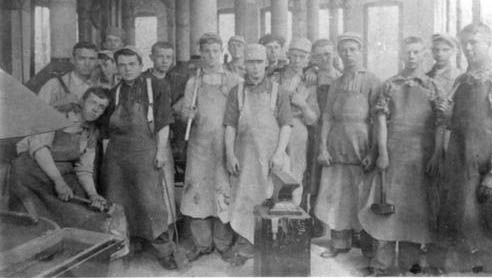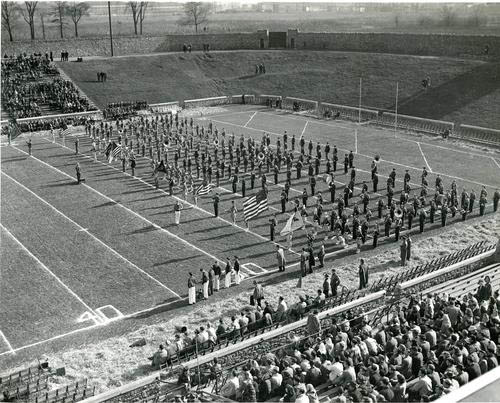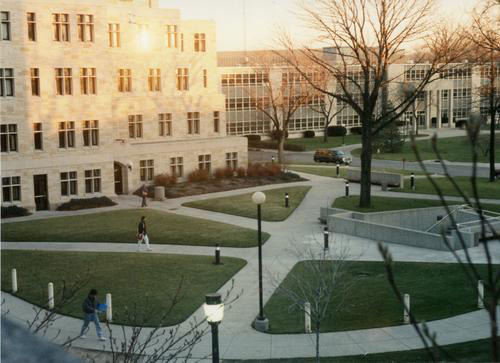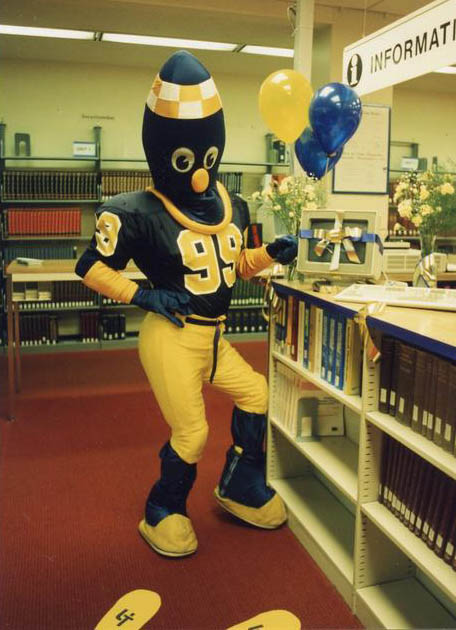UToledo History
Toledo University of Arts and Trades, 1872-1884
In 1868, Jesup Wakeman Scott had a dream. The Toledo newspaper editor believed that the center of world commerce was moving westward and by 1900 would be located in Toledo. In 1872, Scott donated 160 acres of land as an endowment for a university to train the city's young people. (That land later became the Scott Park Campus.)
The Toledo University of Arts and Trades was incorporated on Oct. 12, 1872. Unfortunately, Scott died in 1874, a year before the University actually opened in the basement of a half-finished Unitarian Church known as Raymond Hall on the corner of Adams and 10th Street downtown. At the time, the University had one teacher and two or three courses on painting and architectural drawing for its 26 students. The school closed in 1878 due to a lack of funds.
Toledo Manual Training School, 1884-1914
 On Jan. 8, 1884, the assets of the University were turned over to the city of Toledo.
The school reopened that year as the Manual Training School in two rooms at Central
High School. Students at least 13 years old received instruction in the “practical
arts and trades.”
On Jan. 8, 1884, the assets of the University were turned over to the city of Toledo.
The school reopened that year as the Manual Training School in two rooms at Central
High School. Students at least 13 years old received instruction in the “practical
arts and trades.”
In 1886, the school began admitting female students. Courses included sketching and technical drawing, wood working, metal working, cooking and housekeeping. Toledoans believed the school to be one of the first and best of its kind in the nation.
Dr. Jerome Raymond was appointed the first president of the University in 1908. He expanded its offerings by affiliating with the Toledo Conservatory of Music, the YMCA College of Law and the Toledo Medical College. He also created the College of Arts and Sciences.
The school was becoming an institution of higher education. But it struggled through years of inadequate finances and legal battles over control.
Toledo University, 1914-1967
The University began to move away from a secondary school focus to become an institution that granted baccalaureate degrees. A new University building formally opened on the corner of 11th and Illinois Street on Jan. 30, 1914. That same year the Medical College closed for not meeting new physician licensing standards. The University gained a College of Pharmacy from the brief relationship.
 Also that year, Dr. A. Monroe Stowe became president and led the University on its
first organized path of development. He founded the College of Commerce and Industry
(later the College of Business and Innovation) in 1914 and the College of Education
in 1916. Enrollment grew from 200 students to 1,400.
Also that year, Dr. A. Monroe Stowe became president and led the University on its
first organized path of development. He founded the College of Commerce and Industry
(later the College of Business and Innovation) in 1914 and the College of Education
in 1916. Enrollment grew from 200 students to 1,400.
In 1915, the students petitioned for an intercollegiate athletic program. Two years later, the University fielded its first football team. The team lost its first game 145-0 to the University of Detroit. The sports teams would later receive their nickname, the "Rockets," in 1923 from a newspaper writer who thought the name reflected the teams' playing styles. Student Council was created in 1919, and that year two students started a newspaper called The Universi-Teaser.
By the 1920s, the University had changed its name to Toledo University. It soon outgrew its location. Classes were held in two downtown buildings, but both were too small. In 1922, the University moved into an automobile mechanics training facility that had been constructed for World War I on the original Scott land. While twice the size of the old buildings, this location still wasn’t large enough. Enrollment increased 32% in one year, resulting in a critical shortage of classroom and office space.
 Prospects for a new, permanent home improved in 1928 when Dr. Henry J. Doermann became
president. His first mission was to initiate plans for a new campus. To pay for the
proposed buildings, the city placed a bond levy before Toledo's voters. An all-out
campaign led to the levy's passage by 10,000 votes just 11 months before the start
of the Great Depression.
Prospects for a new, permanent home improved in 1928 when Dr. Henry J. Doermann became
president. His first mission was to initiate plans for a new campus. To pay for the
proposed buildings, the city placed a bond levy before Toledo's voters. An all-out
campaign led to the levy's passage by 10,000 votes just 11 months before the start
of the Great Depression.
The new campus would be built on Bancroft Street. A local architectural firm planned the new campus. Dr. Doermann wanted the buildings to reflect the best design elements of the universities of Europe. He felt such architecture would inspire students.
It took 400 men less than one year to complete University Hall and the Field House in the Collegiate Gothic design in 1931.
While enrollment remained stable during most of the Depression, the University's finances were strapped. Dr. Philip C. Nash, who became president following Dr. Doermann's sudden death, instituted drastic measures to cut costs. Funds from the federal government's New Deal programs helped by paying for new buildings and student scholarships.
World War II transforms UToledo
The University survived the Depression, but it was World War II and its aftermath that transformed UToledo into the modern university it is today. The impact of the war was felt almost immediately. The military contracted with the University to offer war training programs for military members and civilians. For civilians, it offered Engineering, Science and Management War Training program classes and Civilian Pilot Training classes. For the military, the University contracted in 1943 to house, feed and train a detachment of the 27th Army Air Crew. The U.S. Cadet Nurse Corps also trained nurses for Army field hospitals here.
 Student social life changed with the war. It was the first university in the country
to have a Red Cross chapter. The group sponsored knitting bees to make sweaters for
soldiers. Weekly air raid drills were held. With a dwindling number of male students,
women assumed leadership roles on campus. Intercollegiate basketball and football
were suspended. And, tragically, more than 100 students were killed in the war.
Student social life changed with the war. It was the first university in the country
to have a Red Cross chapter. The group sponsored knitting bees to make sweaters for
soldiers. Weekly air raid drills were held. With a dwindling number of male students,
women assumed leadership roles on campus. Intercollegiate basketball and football
were suspended. And, tragically, more than 100 students were killed in the war.
After the war, the GI Bill of Rights rewarded veterans for their service by paying their college tuition. More than 3,000 veterans took advantage of the University's programs. Many veterans were older and had families. So arrangements were made to house them. In 1945, the University purchased surplus military housing and moved it to campus for the veterans. "Nashville," as the complex was called, served as married student housing until 1974.
In 1947, Wilbur W. White replaced Dr. Nash, who had died the previous year. White proposed a progressive 10-year development plan. But he died in 1950 before any new buildings were completed.
He was succeeded by Asa S. Knowles. Dr. Knowles oversaw the completion of a men's dormitory in 1952 and the library in 1953. He expanded educational programming for adult students and created the Greater Toledo Television Foundation to use television for educational purposes.
Dr. Knowles resigned the presidency in 1958. His last official act was to meet with Toledo City Council to discuss the future financing of the University. More than 12% of the city's budget was allocated to the University, and this could not continue. Council suggested that the University consider acquiring financial assistance from the state to provide the funding needed for it to grow.
It was left to President William S. Carlson to pursue the issue. Three bills introduced into the state legislature in 1959 proposed a student subsidy for the state's three largest municipal universities. But all stalled, and the University's financial situation worsened.
Fortunately, a 2-mill levy in 1959 passed by just 144 votes, raising $1.7 million a year for the University. The three municipal universities of Akron, Cincinnati and Toledo continued to press for state financial assistance. On July 1, 1967, the University was given the status of a state-funded university by the Ohio General Assembly and became known as The University of Toledo. In addition to subsidies for students, state support provided capital improvement money for a campus building boom.
The University of Toledo, 1967-Present
 College students became more politically active in the 1960s. The decade produced
frequent student protests across the nation. Most of the UToledo protests were peaceful,
like a "food riot" by dormitory students in 1968 who were upset over the quality of
food.
College students became more politically active in the 1960s. The decade produced
frequent student protests across the nation. Most of the UToledo protests were peaceful,
like a "food riot" by dormitory students in 1968 who were upset over the quality of
food.
More serious protests by students opposed to the war in Vietnam did lead to several arrests. In 1970, the campus remained peaceful following the deaths of four student protesters at Kent State University. A protest by black students following the killing of students at Jackson State University in Mississippi temporarily closed University Hall in May of that year. The protest ended when President Carlson met with the students and reached a peaceful accord.
UToledo marked its centennial in 1972 with a year of celebrations. President Carlson retired that year. Dr. Glen R. Driscoll was selected as his successor. Dr. Driscoll oversaw further expansion of the University's physical plant with the addition of the Center for Performing Arts (1976), Savage Hall (1976), the Center for Continuing Education (1978) and Stranahan Hall (1984).
 Centennial Mall, a nine-acre landscaped mall in the center of campus, replaced parking
lots and Army barracks in 1980. Construction began in 1985 on SeaGate Center, a downtown
complex of classrooms and meeting rooms that was part of downtown Toledo's revitalization
efforts.
Centennial Mall, a nine-acre landscaped mall in the center of campus, replaced parking
lots and Army barracks in 1980. Construction began in 1985 on SeaGate Center, a downtown
complex of classrooms and meeting rooms that was part of downtown Toledo's revitalization
efforts.
In 1985, Dr. Driscoll retired, and was replaced by Dr. James D. McComas. Dr. McComas continued the expansion. McMaster Hall (1987) was completed, and plans were made for the Student Recreation Center (1990), the Larimer Athletic Complex (1990), the Greek Village (1990) and renovations to the Glass Bowl Stadium (1990). Dr. McComas's tenure at UToledo was brief. He resigned in 1988.
UT 40 campaign launched
Dr. Frank E. Horton, president of the University of Oklahoma, was selected The University of Toledo's 13th president in October 1988. To meet the challenges of the 1990s, Dr. Horton began a lengthy strategic planning effort to chart a course of targeted, purposeful growth. To help achieve the plan's many goals, in 1993 the University launched a $40 million fund-raising campaign called UT 40.
The University continued to expand its physical environs in the 1990s. A major expansion of the campus took place when UToledo renovated commercial buildings at Dorr Street and Secor Road for classrooms. A new academic center and residence hall (1992) was built to house the Honors Program.
Other new buildings included the University Health Center (1992), the Center for the Visual Arts at the Toledo Museum of Art (1992), the International House Residence Hall (1995) and Nitschke Hall (1995). Construction began in 1995 on a Pharmacy, Chemistry and Life Sciences complex on the Main Campus and a Lake Erie Research Center at Maumee Bay State Park.
 The ’90s also saw significant growth in technology. The University joined OhioLINK,
a statewide library network, in 1994. Computer labs and hook-ups in dormitories and
offices provided Internet access to most. Technological improvements allowed students
to register for classes and check their grades online. The University established
a homepage on the World Wide Web and began to experiment with offering online classes.
The ’90s also saw significant growth in technology. The University joined OhioLINK,
a statewide library network, in 1994. Computer labs and hook-ups in dormitories and
offices provided Internet access to most. Technological improvements allowed students
to register for classes and check their grades online. The University established
a homepage on the World Wide Web and began to experiment with offering online classes.
In 1999, Dr. Vik Kapoor became the University’s 14th president following Horton’s retirement. Kapoor embarked on a restructuring program that included major resource reallocation and administrative reorganization. The Community and Technical College, established in 1968 on the University’s Scott Park Campus, was abolished. In June 2000, Kapoor resigned, and was replaced the following year by Dr. Daniel Johnson.
Johnson’s agenda focused on reconnecting the University to the community through outreach and engagement activities, and the University’s mission was rewritten to describe UToledo as a metropolitan research university. Planning began on a science and technology corridor to encourage research partnerships with businesses. Construction projects on Main Campus included renovations to several older buildings, including the Memorial Field House, which was transformed from a basketball arena into a classroom building; it reopened in 2008 after several years of standing empty.
UToledo-MUO Merger
In 2006, the University saw another fundamental change with the merger of UToledo and the Medical University of Ohio, which had been founded as a separate state-supported institution in 1964 as the Medical College of Ohio.
House Bill 478 was signed on March 31, 2006, by Gov. Bob Taft, creating a university built around eleven academic colleges and professional programs matched only by a handful of public universities nationwide, including Ohio State University and the University of Michigan. As part of the merger, Dr. Lloyd Jacobs, who had been president of MUO, was named president of the merged university. UToledo became one of few universities nationwide to offer degrees in medicine, law, engineering, business, nursing, pharmacy and education.
The existing UToledo campus, located along the banks of the Ottawa River in a residential section of the city, was named Main Campus. The previous Medical College of Ohio campus, home to the Medical Center and clinics and many of the health sciences research and education programs, was named Health Science Campus.
UToledo Looks to the Future
In 2015, UToledo welcomed its first female president, Dr. Sharon L. Gaber. As the University's 17th president, Dr. Gaber worked oversaw the implementation of an academic affiliation agreement between the UToledo College of Medicine and Life Sciences and ProMedica, a regional health-care system, as well as a new strategic plan and a multiple-campus master plan.
Dr. Gregory Postel became UToledo’s 18th president on March 2, 2021, after serving as interim president since July 6, 2020. Under Dr. Postel’s leadership, UToledo navigated the COVID-19 pandemic, created the UToledo Reimagined strategic plan, received reaffirmation of Higher Learning Commission accreditation, and strengthened the finances and operations of the University of Toledo Medical Center and created UToledo Health.
Following a national search, Dr. James Holloway was named the University’s 19th president on May 22, 2025. He assumed the role on July 15, 2025, succeeding Interim President Matt Schroeder, the University's Executive Vice President for Finance and Administration and Chief Financial Officer, who had led UToledo on an interim basis since May 20, 2024.
Despite the challenges facing higher education in the 21st century, The University of Toledo today is a success story.
UToledo is recognized among the country’s top-tier research universities with the prestigious Carnegie R1 Classification. Announced in February 2025, UToledo earned the "very high research activity" designation in the latest Carnegie Classification of Institutions of Higher Education. There are 187 total institutions of higher education with an R1 classification in the nation, and seven total in Ohio including UToledo, which is the only one in the region.
UToledo is celebrating record student success with the highest six-year graduation rate and first-to-second-year retention rates in history. The University earns high marks for social and income mobility. UToledo is a top five university for earnings after graduation, according to the U.S. Census Bureau post-secondary employment outcomes data. The University is additionally among the top three for lifetime return on investment, according to the Bipartisan Policy Center, and has been ranked No. 2 by the Wall Street Journal for time to repay among Ohio’s public universities.
If the past is any indication, UToledo will meet future challenges and the institution will continue to be a transformative public research university and academic medical center that amplifies the initiative of our people.


